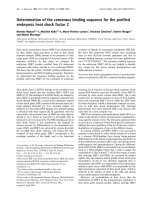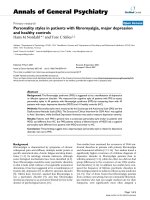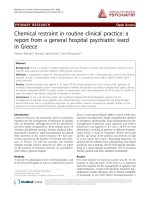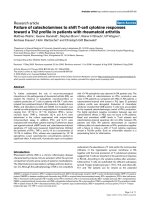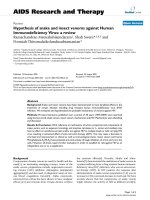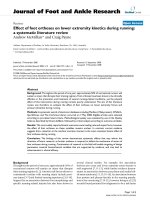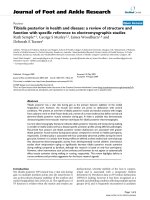Báo cáo y học: "Enhancement of in vitro interleukin-2 production in normal subjects following a single spinal manipulative treatment" potx
Bạn đang xem bản rút gọn của tài liệu. Xem và tải ngay bản đầy đủ của tài liệu tại đây (285.3 KB, 9 trang )
BioMed Central
Page 1 of 9
(page number not for citation purposes)
Chiropractic & Osteopathy
Open Access
Research
Enhancement of in vitro interleukin-2 production in normal subjects
following a single spinal manipulative treatment
Julita A Teodorczyk-Injeyan
1
, H Stephen Injeyan*
2
, Marion McGregor
1
,
Glen M Harris
3
and Richard Ruegg
3
Address:
1
Division of Graduate Education and Research, Canadian Memorial Chiropractic College, Canada,
2
Division of Foundational and
Professional Education, Canadian Memorial Chiropractic College, Canada and
3
Division of Clinical Education, Canadian Memorial Chiropractic
College, Canada
Email: Julita A Teodorczyk-Injeyan - ; H Stephen Injeyan* - ; Marion McGregor - ;
Glen M Harris - ; Richard Ruegg -
* Corresponding author
Abstract
Background: Increasing evidence supports somato-visceral effects of manual therapies. We have previously
demonstrated that a single spinal manipulative treatment (SMT) accompanied by audible release has an inhibitory
effect on the production of proinflammatory cytokines in asymptomatic subjects. The purpose of this study is to
report on SMT-related changes in the production of the immunoregulatory cytokine interleukin 2 (IL-2) and to
investigate whether such changes might differ with respect to the treatment approach related to the presence or
absence of an audible release (joint cavitation).
Methods: Of 76 asymptomatic subjects, 29 received SMT with cavitation (SMT-C), 23 were treated with SMT
without cavitation (SMT-NC) and 24 comprised the venipuncture control (VC) group. The SMT-C and SMT-NC
subjects received a single, similar force high velocity low amplitude manipulation, in the upper thoracic spine.
However, in SMT-NC subjects, positioning and line of drive were not conducive to cavitation. Blood and serum
samples were obtained before and then at 20 and 120 min post-intervention. The production of IL-2 in peripheral
blood mononuclear cell cultures was induced by activation for 48 hr with Staphylococcal protein A (SPA) and, in
parallel preparations, with the combination of phorbol ester (TPA) and calcium ionophore. The levels of IL-2 in
culture supernatants and serum were assessed by specific immunoassays.
Results: Compared with VC and their respective baselines, SPA-induced secretion of IL-2 increased significantly
in cultures established from both SMT-C and SMT-NC subjects at 20 min post-intervention. At 2 hr post-
treatment, significant elevation of IL-2 synthesis was still apparent in preparations from SMT-treated groups
though it became somewhat attenuated in SMT-NC subjects. Conversely, IL-2 synthesis induced by TPA and
calcium ionophore was unaltered by either type of SMT and was comparable to that in VC group at all time points.
No significant alterations in serum-associated IL-2 levels were observed in any of the study groups.
Conclusion: The present study demonstrates that, the in vitro T lymphocyte response to a conventional mitogen
(SPA), as measured by IL-2 synthesis, can become enhanced following SMT. Furthermore, within a period of time
following the manipulative intervention, this effect may be independent of joint cavitation. Thus the results of this
study suggest that, under certain physiological conditions, SMT might influence IL-2-regulated biological
responses.
Published: 28 May 2008
Chiropractic & Osteopathy 2008, 16:5 doi:10.1186/1746-1340-16-5
Received: 16 November 2007
Accepted: 28 May 2008
This article is available from: />© 2008 Teodorczyk-Injeyan et al; licensee BioMed Central Ltd.
This is an Open Access article distributed under the terms of the Creative Commons Attribution License ( />),
which permits unrestricted use, distribution, and reproduction in any medium, provided the original work is properly cited.
Chiropractic & Osteopathy 2008, 16:5 />Page 2 of 9
(page number not for citation purposes)
Background
Two of the most intriguing controversies surrounding the
chiropractic profession are: 1) the biological mechanisms
associated with spinal manipulation [1,2], and 2) the clin-
ical impact of the audible release that comes from a high
velocity, low amplitude force directed to a spinal joint [3].
The research reported here adds to the body of knowledge
in each of these important areas: samples of cell culture
supernatants obtained in the course of an earlier study
examining the effect of spinal manipulation on selected
parameters of the immune response [4] were evaluated for
changes in the capacity for production of the immunoreg-
ulatory cytokine, interleukin 2 (IL-2), pre- and post-inter-
vention, as well as, between manipulation characterized
by an audible release (cavitation) and manipulation with-
out audible release.
The current model of spinovisceral (somatoautonomic)
reflex provides a link between spinal manipulation, the
autonomic nervous system (ANS) and various visceral
functions [5]. Although experimental studies have dem-
onstrated that somatoautonomic reflex effects are evident
in various non-musculoskeletal systemic reactions [6]
studies in humans are still limited, particularly with
respect to the effect of spinal manipulative therapy (SMT)
on the integrated responses of the nervous and immune
systems. Clarification of such a relationship can have clin-
ical implications in the area of manual interventions in
pursuit of somato-visceral outcomes. Our recent studies
on asymptomatic subjects receiving a single high velocity
low amplitude spinal manipulation (HVLA), character-
ized by cavitation (audible release), in the thoracic spine,
demonstrated suppression of the in vitro production of
two proinflammatory cytokines, tumor necrosis factor α
(TNFα) and interleukin 1β (IL-1β) [4] relative to subjects
receiving a high velocity, low amplitude force applied to
the thoracic spine, without cavitation. Earlier studies by
Brennan et al. [7] suggested that a series of high force,
HVLA manipulations of the lumbosacral spine of low
back patients, as well as asymptomatic controls, did not
result in quantitative changes of lymphocyte subpopula-
tions in peripheral blood samples collected from either
group. To our knowledge, however, the effect of SMT (of
any type) on the functional activity of these cells, includ-
ing their capacity for cytokine production, has not been
studied.
IL-2, originally identified as a T-cell growth factor, is now
recognized as a pivotal cytokine in T-cell dependent
immune responses [8]. An increasing body of evidence
indicates also that IL-2 plays a major role in the develop-
ment, maintenance and survival of regulatory T cells war-
ranting its critical importance in the induction and
sustenance of immune tolerance [9]. Determinations of in
vivo (serum) IL-2 levels have been applied in clinical stud-
ies in which systemic activation of T-cells is suspected
[10]. On the other hand, assessment of the in vitro produc-
tion of this cytokine by mitogen-stimulated human cell
cultures has been long used as a standard procedure for
scrutinizing the capacity of T lymphocytes to become acti-
vated [11]. Thus, both in vivo and in vitro determinations
of IL-2 have been utilized in this investigation. Further-
more, the in vitro induction of IL-2 synthesis may be
achieved either via mitogen-related transmembrane sign-
aling or by a chemical stimulation which bypasses such
requirements. Both methods have been utilized in the
present study.
It has been suggested that cavitation (the audible release)
associated with HVLA is what "truly" distinguishes SMT
from other manipulation-type modalities [12]. The inter-
vention methods used in this investigation are consistent
with this notion. That is, HVLA forces were applied to
some subjects with the intent of producing an audible
release, and in other subjects with the intent of not pro-
ducing a release. Controversy remains as to whether cavi-
tation results in any clinically relevant differences [13,14].
Studies have not yet been conducted to determine if dif-
ferences due to cavitation exist at a cellular/molecular or
immunological level. This investigation begins such an
exploration.
Methods
Subjects
All subject-handling procedures were approved by the
Canadian Memorial Chiropractic College (CMCC)
Research Ethics Board. The present study was part of a
larger investigation in which blood samples were
obtained from 82 age- and sex-matched participants to
test for changes in different parameters of the immune
response following a spinal manipulative intervention.
Subjects naive to spinal manipulation were recruited
through announcements and advertisement from CMCC
students within the first two weeks of entering their first
year of study, first year naturopathic students, or the com-
munity at large. In the present study, for determination of
IL-2 levels, samples were available from 76 of the subjects
(Table 1).
Table 1: Demographic data of subjects
Group Age (years) Sex (female/male)
VC, n = 24 24.1 ± 1.5 15/9
SMT-NC n = 23 25.3 ± 1.21 13/10
SMT-C n = 29 24.8 ± 1.75 15/14
VC, venipuncture control; SMT-NC, spinal manipulative therapy-no
cavitation;
SMT-C, spinal manipulative therapy-cavitation.
Chiropractic & Osteopathy 2008, 16:5 />Page 3 of 9
(page number not for citation purposes)
Details of the experimental design and protocol have been
described previously in the context of investigating
changes in proinflammatory cytokine production in the
same subjects [4]. Briefly, subjects were accepted into the
study if they had not received previous chiropractic treat-
ments regularly and had not received any manipulative
treatments for a minimum of the previous 6 months; and
in whom the study clinician was able to identify a
restricted motion segment in the upper thoracic spine.
Patients were excluded if they had current aches or pains
due to any complaints, recent or current strain/sprain type
injuries, infections or fracture, a history of neoplasm or
other diseases involving the immune system, or history of
recent emotional or physical trauma. They were screened
by a single clinician, using motion and static palpation,
for notional restrictions in segmental motion in the upper
thoracic spine (T1–T6). Subjects in whom no restrictions
could be identified were dismissed from the study.
Those accepted into the study were randomly assigned to
one of 3 groups: spinal manipulation with cavitation
(SMT-C), spinal manipulation without cavitation (SMT-
NC) or venipuncture control (VC). SMT consisted of a sin-
gle bilateral hypothenar push (Carver Bridge) adjustment
[15] applied to the involved vertebral segment and with
sufficient force so as to produce joint cavitation as judged
by the treating clinician. For SMT-C force was applied to
the restricted segment in a direction normal to the surface
of that region of the thoracic spine, and the thrust was
delivered downwards albeit with a cephalad component
inherent to the Carver Bridge procedure. The procedure
for SMT-NC consisted of an identical set-up using similar
force but with positioning and line of drive essentially in
an extreme cephalad direction with the intention of
avoiding joint cavitation. In two instances, where cavita-
tion did occur, subjects were designated to the SMT-C
group. In an earlier study using the same subjects, we had
referred to this latter group as having received a sham
manipulation [4]. Subjects in the VC group received only
the set up "joint loading" without the application of
thrust.
Both heparinized and non-heparinized blood samples
were obtained from all subjects prior to intervention and
then at 20 min and 2 hr post-intervention. The former
were used for studies of the in vitro production of IL-2,
while systemic (in vivo) levels of IL-2 production were
determined in sera derived from non-heparinized blood
samples. A coding system was used that allowed blinding
of the venipuncturist and laboratory investigators to the
subjects in all three groups. All samples to be examined
were thawed immediately before testing.
In vitro IL-2 levels
The in vitro studies were carried out to investigate if the
capacity for an inducer-related IL-2 production by periph-
eral blood mononuclear cells (PBMCs) isolated from
heparinized blood samples was altered as a result of SMT.
In addition, because, PBMCs can synthesize low levels of
IL-2 spontaneously (that is without stimulation) the
amounts of IL-2 synthesized in cultures cultivated in the
absence of inducer were also determined.
Peripheral blood mononuclear cell (PBMC) culture system
PBMCs were isolated by density gradient centrifugation
on Ficoll-Hypaque according to the protocol recom-
mended by the producer (Pharmacia Biotech, Uppsala,
Sweden). Cells were then prepared for in vitro studies
essentially as described previously [10]. Tissue culture
medium (TCM) used throughout the study consisted of
RPMI 1640 supplemented with a pretested batch of fetal
calf serum (10%v/v), 2 mM L-glutamine, 5 × 10
-5
M 2-
mercaptoethanol (Sigma, ST. Louis, MO) and antibiotics.
All solutions were freshly prepared from stocks by diluting
with TCM to desired concentrations. PBMCs were sus-
pended in TCM at a concentration of 1 × 10
6
/ml and aliq-
uoted, in duplicate, into tissue culture tubes for
cultivation.
Induction of IL-2 production
IL-2 synthesis in PBMC cultures was induced by two dif-
ferent methods. The conventional mitogen, Staphylococ-
cal protein A (SPA) [16], (Pharmacia Chemicals, Uppsala,
Sweden) was used at a final concentration of 10 μg/ml. In
parallel cultures, IL-2 synthesis was induced by the appli-
cation of the combination of phorbol ester 12-o-tetrade-
canoyl-phorbol-13-acetate (TPA) and calcium ionophore
A23187 [17]. A23187 (Sigma) was dissolved in ethanol
and used at a concentration of 200 ng/ml and TPA
(Sigma) was prepared in DMSO, and used at the final con-
centration of 3 × 10
-8
M. Cultures were maintained for 48
hr at 37°C in a humidified 5% CO
2
incubator. At the con-
clusion of the incubation period, culture supernatants
from each subject were pooled, aliquoted and frozen at -
78°C until further analysis.
The assay procedure
The levels of IL-2 in supernatants from PBMC cultures
were determined by specific enzyme-linked immunosorb-
ant assays (ELISA) using DuoSet ELISA development sys-
tem for natural and recombinant human cytokines (R&D
Systems, Minneapolis, MN). Briefly, Immulon 4 HBX, flat
bottom microtiter plates (Thermo Labsystems, Franklin,
MA) were coated with a predetermined concentration of
mouse anti-human IL-2 antibody. After washing and
blocking the wells with bovine serum albumin, duplicate
dilutions of standards (defined amounts of a human
recombinant IL-2) or of the test supernatants were added
Chiropractic & Osteopathy 2008, 16:5 />Page 4 of 9
(page number not for citation purposes)
to the wells and incubated for 2 hours. Plates were then
washed and incubated with a specific detection antibody
(biotinylated goat anti-human anti-IL-2 antibody). After
20 min incubation and multiple washing, the plates were
incubated for 20 min with streptavidin-HPR solution and
then with substrate solution (mixture of H
2
O
2
and tetram-
ethylbenzidine). Following the development of colour,
the absorbance was measured at 450 nm using an auto-
mated microplate reader (ELx800, Bio-Tech Instruments,
Inc. Winooski, Vermont, USA). Concentrations of IL-2
were calculated from the linearized (best fit) standard
curve determined by regression analysis. Each culture
supernatant was tested at least twice at 2–4 different dilu-
tions in order to ascertain if determinations of IL-2 were
within the parameters of the standard curve.
In vivo (serum) IL-2 levels
The in vivo (systemic) production of IL-2 was examined by
determination of the serum content of IL-2. Non-
heparinized blood (5 ml) was drawn into a separation
tube and placed in ice. After 1 hour, these specimens were
centrifuged at 4°C and sera were aliquoted to be frozen at
-78°C until use. Just prior to assays being done, samples
were thawed, diluted with phosphate buffered saline
(PBS) supplemented with 10% FCS, and processed by
ELISA as described above.
Enumeration of cells
A quantitative analysis of peripheral mononuclear cells
was performed as described previously [18].
Statistics
Significant inter-individual variability in the capacity of
human cytokine production is typical even though within
individual production is relatively constant [19,20]. Nor-
mality tests of sample data indicated that the distribution
of baseline and both early (20 minute) and late (2 hour)
post-intervention measures were within tolerable limits
[21]. Analysis of covariance (ANCOVA), was therefore
used to assess for differences between intervention condi-
tions (venipuncture control, HVLA force with audible
release and without) at each outcome time, while consid-
ering baseline measurement as the covariate to account
for any initial between-group differences. Stata SE8 was
used to perform the ANCOVAs.
Results
IL-2 synthesis in vitro
Constitutive (spontaneous) and inducer-related synthesis
of IL-2 were both examined in PBMC cultures. Constitu-
tive synthesis of IL-2 was determined in supernatants
from unstimulated (inducer-free) cultures cultivated in
parallel to inducer-activated preparations. Only cultures
for which a complete set of data was available were
included in the final analysis. Routine flow cytometry
(FACS) examination of cell surface markers ascertained
that the numbers of IL-2 producing lymphocytes were
comparable in all PBMC preparations.
Constitutive (spontaneous) production of IL-2
Seven (2 each in VC and SMT-NC and 3 in SMT-C group)
of 76 subjects investigated in this study demonstrated no
detectable IL-2 synthesis in unstimulated PBMC cultures
both prior to and post-intervention. The levels of IL-2
released spontaneously in cultures from the remaining
subjects showed no significant alterations over the study
period. The mean levels of synthesis of IL-2 in these prep-
arations ranged from 29–41 pg/ml and were comparable
in all study groups before (baseline) and at 20 min and 2
hr post-intervention. This suggested that neither the veni-
puncture procedure alone nor manipulative intervention
(SMT-NC or SMT-C) altered the state of activation of cir-
culating IL-2-producing lymphocytes.
IL-2 production induced by SPA
Twenty minutes post-intervention
The production of IL-2 increased in cultures from SMT-C
as well as SMT-NC subjects relative to baseline and veni-
puncture controls 20 minutes following the manipulative
interventions. Analysis of covariance results revealed sta-
tistically significant differences between the groups at this
time point (F = 7.67, p = 0.001). In particular, post-hoc
analysis determined a statistically significant difference
between the venipuncture control (VC) and the group
that received the manipulation with an audible release
(cavitation – SMT-C) (F = 14.30, p = 0.000). A statistically
significant difference was also found between the VC and
the group that received a manipulation without an audi-
ble release (no cavitation – SMT-NC) (F = 8.01, p =
0.006). No difference was found in post-hoc comparison
between the SMT-C and SMT-NC (F = 0.61, p = 0.436).
These results are represented graphically in Figure 1A.
Two hours post-intervention
An increase in IL-2 production was also apparent in cul-
tures from both SMT-C and SMT-NC subjects relative to
baseline and venipuncture controls. Analysis of covari-
ance revealed a statistically significant difference between
groups at two hours after the intervention (F = 7.51, p =
0.001). Once again, post-hoc analysis showed this differ-
ence to be between the VC and SMT-C (F = 12.99, p =
0.001) as well as between the VC and SMT-NC (F = 9.54,
p = 0.003). Again, no difference was found between the
SMT-NC and SMT-C (F = 0.11, p = 0.737) (Fig 1B). Inter-
estingly, the graphical representations in Figure 1 show
that while statistically, the results from two hours are
almost identical to those at 20 minutes, some degradation
of the line associated with SMT-NC already appears to
have occurred.
Chiropractic & Osteopathy 2008, 16:5 />Page 5 of 9
(page number not for citation purposes)
SPA-induced IL-2 secretion in cultures established 20 minutes (A) and 2 hours (B) post-intervention (PI)Figure 1
SPA-induced IL-2 secretion in cultures established 20 minutes (A) and 2 hours (B) post-intervention (PI). PBMC
cultures were activated with SPA (10 μg/ml) at initiation and incubated at 37°C for 48 hr. The concentration of IL-2 (pg/ml)
produced in vitro by cells from a subject at 20 min (A) and 2 hr (B) post intervention is plotted against the concentration of IL-
2 produced at baseline by the same subject. Each point represents a subject for whom a complete set of data was available.
Comparison of best fit lines revealed statistically significant differences between SMT-C (spinal manipulative therapy with cavi-
tation, n = 26) and VC (venipuncture, n = 21) as well as SMT-NC (spinal manipulative therapy without cavitation, n = 23) and
VC both for 20 min and 2 hr post intervention (see text for details).
A
B
A
B
A
B
Chiropractic & Osteopathy 2008, 16:5 />Page 6 of 9
(page number not for citation purposes)
IL-2 production induced by TPA
Twenty minutes post-intervention
Analysis of covariance of IL-2 secretion induced by the
combination of TPA and ionophore revealed that at 20
minutes post-intervention there was no significant differ-
ence between the three groups (F = 2.59, p = 0.0846). The
data are represented graphically in Figure 2A.
Two hours post-intervention
Analysis of covariance under this set of experimental con-
ditions (two hours after intervention) was consistent with
the results at 20 minutes. No statistically significant differ-
ence in IL-2 secretion was found between the three groups
(F = 0.22, p = 0.8023), (Fig 2B).
IL-2 synthesis in vivo
Determinations of systemic (in vivo) release of IL-2 were
carried out using serum samples collected at the same
time as PBMCs used for the in vitro studies described
above. As resting lymphocytes do not produce IL-2, sera
from normal individuals contain usually very little or no
detectable IL-2. At baseline, IL-2 was detected in serum
from only 5/24 subjects in VC, 6/23 in SMT-NC and 9/29
in the SMT-C treated subjects. The mean values of detect-
able serum IL-2 levels were comparable in all study groups
(15–21 pg/ml), and remained essentially unaltered dur-
ing the post-intervention period.
Discussion
The biological mechanisms associated with spinal manip-
ulation are poorly understood [1]. However, evidence has
been accumulating that somatovisceral effects may result
from a spinal manipulative therapy [6]. We have previ-
ously demonstrated that a single spinal HVLA manipula-
tion, characterized by cavitation and intended to mobilize
a small joint "fixation" in the upper thoracic spine in
asymptomatic subjects, has a suppressing effect on proin-
flammatory cytokine synthesis by PBMCs in vitro [4]. Ear-
lier studies have demonstrated increased activity of the
innate immune response components following a single
SMT in the upper T-spine of asymptomatic subjects
[22,23]. However, parameters of specific immunity have
not been investigated with a view of determining possible
alterations in lymphocyte functions. In the present study
we have demonstrated that following a spinal manipula-
tive intervention the in vitro synthesis of IL-2 increases sig-
nificantly, both with and without cavitation, for at least
the short term (20 min post-SMT). These results are
important from two different perspectives: a) the effect
(increase) may be independent of joint cavitation and b)
the response is evident in mitogen (SPA)-activated cul-
tures (Figs 1A, 1B) but not those stimulated by the combi-
nation of TPA and calcium ionophore (Figs 2A, 2B)
The design of our study does not allow for speculation as
to the mechanism(s) involved in the transduction of a
putative effect of the manipulative thrust to the cellular/
molecular level in vivo. However, the in vitro application of
two inducers dissimilar with respect to the route by which
the activating signal was provided allows for an insight
into the mechanism of SMT action in our experimental
model system. SPA is suggested to induce preferential acti-
vation of CD4+ (Th1) cells through its ability for cross-
linking with the MHC class II molecules on the surface of
antigen presenting cells APC [24]. The application of
phorbol ester and calcium ionophore by-passes this
requirement and mobilizes molecular mechanisms of IL-
2 synthesis directly [25,26]. The results of the present
study demonstrate clearly that manipulative intervention
provided by spinal manipulation of the thoracic spine,
results in a significant augmentation of IL-2 secretion in
vitro induced by SPA.
The increased IL-2 synthesis by PBMCs was not accompa-
nied by a systemic (in vivo) release of IL-2 in response to
any of the interventions. Thus, at baseline, serum IL-2 was
detected in a small number of subjects and did not
increase post-manipulation. Similarly, constitutive (spon-
taneous) in vitro secretion of IL-2 remained consistently
comparable in all study groups. It is therefore unlikely
that the observed increments in SPA-induced production
of IL-2 ensued from in vivo (systemic) pre-activation of cir-
culating peripheral blood T lymphocytes. Rather, it is pos-
sible that the manipulative interventions had a priming
effect on cells/factors in vivo with a subsequent enhancing
effect on the interaction between antigen presenting cells,
principally dendritic cells (DCs), and T lymphocytes. Such
improved interaction has been shown to be mediated by
another cytokine, interleukin 15 (IL-15) resulting in
increased IL-2 production by T lymphocytes, such as
observed in our study. Interestingly, IL-15 which is highly
expressed in neural tissues and skeletal muscles [27] is
released in large quantities following physical stress
[28,29].
In the present study, it is not known if any of the proce-
dures (including the "laying on of the hands", the manip-
ulative thrust) to which participants were subjected to,
were sufficiently stressful to cause an increase in the sys-
temic output of IL-15. Venipuncture controls were exam-
ined and touched by the clinician in a manner
comparable to the SMT groups, making it unlikely that the
observed effect on IL-2 synthesis is due to "laying on of
the hands" or anticipation-related stress. What remains
common to both SMT-C and SMT-NC is the manipulative
force. It has been reported that a threshold force may be
required in order to attain SMT-related physiological
changes [23]. Manipulative forces were not measured in
this study and we cannot stipulate as to the magnitude of
Chiropractic & Osteopathy 2008, 16:5 />Page 7 of 9
(page number not for citation purposes)
Phorbol ester (TPA)-induced IL-2 secretion in PBMC cultures established 20 minutes (A) and 2 hours (B) post-intervention (PI)Figure 2
Phorbol ester (TPA)-induced IL-2 secretion in PBMC cultures established 20 minutes (A) and 2 hours (B) post-
intervention (PI). PBMC cultures were activated with the combination of TPA (3 × 10
-8
M) and calcium ionophore A23187
(200 ng/ml) at initiation and incubated at 37°C for 48 hr. IL-2 levels were determined in culture supernatants by specific ELISA.
Each point represents the concentration of IL-2 (ng/ml) produced in vitro by cells from a subject at 20 min (A) and 2 hr (B) post
intervention plotted against the concentration of IL-2 produced at baseline by the same subject. Each point represents a sub-
ject for whom a complete set of data was available. Comparison of best fit lines revealed no statistically significant differences
between SMT-C (spinal manipulative therapy with cavitation, n = 22) and VC (venipuncture, n = 16) as well as SMT-NC (spinal
manipulative therapy without cavitation, n = 17) and VC both for 20 min and 2 hr post intervention (see text for details).
A
B
Chiropractic & Osteopathy 2008, 16:5 />Page 8 of 9
(page number not for citation purposes)
force to which participants in the SMT-NC or SMT-C
groups were subjected. However, it is feasible that manip-
ulative forces and intervention-related stress increased the
systemic levels of IL-15 in both SMT-C and SMT-NC
groups. This could improve DC interaction with T lym-
phocytes and increase IL-2 production. Finally, IL-15-acti-
vated DCs themselves produce IL-2 in considerable
quantities [30]. The process of DC stimulation resulting in
IL-2 synthesis requires the presence of both T lymphocytes
and microbial product. [31]. In the present study, these
conditions were met in SPA- but not TPA-stimulated cul-
tures of PBMCs, which overall, showed no alterations in
IL-2 production (Figs 2A, 2B).
The observed IL-2 increase might also be due to an
increase in the number of DCs. Earlier studies have
revealed no quantitative changes in T cells; however, enu-
meration of PBMCs expressing the DC phenotype was not
done. It has been demonstrated that physical stress
increases the number of DC cells in the circulation [32].
Thus, an increase in the number of IL-2 secreting DCs in
the PBMC preparations examined after the intervention,
might explain the observed increase in IL-2 production in
cultures derived from SMT-C and SMT-NC – treated sub-
jects. Future studies of possible alterations in DC numbers
and biological responses following manipulative inter-
ventions should yield informative results in this regard.
The results of this study indicate that the increase in IL-2
synthesis by PBMCs due to a manipulative intervention
was independent of joint cavitation when considered in
the 20 minute time frame following SMT. Statistical anal-
ysis of the data for 2 hours post intervention revealed sim-
ilar results. However, in the absence of cavitation there
was an attenuation of the effect (Fig 1B) suggesting that
joint cavitation may have a longer lasting effect. It may be
argued that increasing the number of participants in the
study groups might have delineated differences between
the SMT-C and SMT-NC groups more clearly. However,
the p values (0.006 or less) revealed by the statistical anal-
ysis indicate that the study had adequate power. Neverthe-
less, future studies will benefit from reproducing these
results with similar or better statistical power, and more
importantly, exploring the time course of IL-2 synthesis,
by making determinations over a longer period (e.g. 1, 2,
3, and 24 hours) following SMT.
While there is controversy around the topic of the clinical
significance of cavitation [13,14,33] the results reported
here, as well as earlier findings of cavitation-dependent-
suppression of proinflammatory cytokines in response to
SMT [4] suggest, that depending on the time-frame of
determinations and/or type of outcomes investigated, cav-
itation may be an important qualifier of a successful
HVLA thrust. A clear association between manipulation of
the lumbar spine and zygapophyseal joint gapping has
been demonstrated by use of magnetic resonance imaging
in normal subjects [34]. However, a relationship between
joint gapping and cavitation remains to be established. It
has been suggested that while cavitation may be a reliable
indicator of joint gapping, the mechanical effects of spinal
manipulation may not be directly related to cavitation
[2,12,33]. Flynn et al. [14] found that an "audible pop"
did not change the outcome for sacroiliac region manipu-
lation in patients with non-radicular low back pain. In
their study all participants were manipulated similarly
and were grouped into "audible pop" and "no audible
pop" post manipulation. However, in this type of design
it is possible that the perceived absence of an "audible
pop" is due the fact that articular release may occur with-
out being audible [35]. In the present study the SMT-NC
group received a manipulative thrust designed not to pro-
duce cavitation. Nevertheless, we realize that in order to
make an assertion with respect to the occurrence or
absence of cavitation more rigorous means need to be
employed. To this end the use of accelometry [36] in
future studies will be useful. In addition, quantification of
manipulative forces will shed further light on the relation-
ship between IL-2 synthesis and HVLA with or without
cavitation.
Conclusion
A single HVLA manipulation to the thoracic spine of
asymptomatic subjects causes a significant enhancement
in IL-2 secretion by PBMCs in vitro. This increase is inde-
pendent of joint cavitation at least for the short term.
However, the duration of the effect appears to be time-
restricted as evidenced by the decline of IL-2 levels 2 hours
post-intervention in the non-cavitating group. These
observations suggest that under certain physiological con-
ditions, SMT could influence, directly or indirectly, IL-2-
regulated biological responses. The results provide impe-
tus for further investigations in order to clarify the rela-
tionship between HVLA manipulation with or without
cavitation and the synthesis of IL-2 and other immunoreg-
ulatory mediators.
Competing interests
The authors declare that they have no competing interests.
Authors' contributions
JTA contributed to the design of the study, was responsi-
ble for all laboratory procedures, analysis of data, and
contributed to the writing of the manuscript.
HSI contributed to the design of the study, was responsi-
ble for subject recruitment and coordination of the study,
analysis of data, and contributed to the writing of the
manuscript, MM performed the statistical analysis of the
data and contributed to the writing of the manuscript,
Chiropractic & Osteopathy 2008, 16:5 />Page 9 of 9
(page number not for citation purposes)
GMH contributed to data analysis and writing of the man-
uscript, RR contributed to the design of the study and was
the study clinician. All authors have read and approved
the final version of the manuscript.
Acknowledgements
The authors thank Dr. J. Kim Ross for his insightful discussions and for crit-
ically reading the manuscript. We are grateful to Ms Janet Hayes RN for
help with venipuncture and Dr. Brodie Nadeau for his assistance in the lab-
oratory. This research was supported by funds from CMCC and a Public
Health Service grant no. U24 AR45166 through the Consortial Center for
Chiropractic Research.
References
1. Pickar JG: Neurophysiological effects of spinal manipulation.
The Spine Journal 2002, 2:357-371.
2. Evans DW: Mechanisms and effects of spinal high-velocity,
low-amplitude thrust manipulation: previous theories. J
Manipulative Physiol Ther 2002, 25:251-262.
3. Bakker M, Miller J: Does an audible release improve the out-
come of a chiropractic adjustment? JCCA J Can Chiropr Assoc
2004, 48(3):237-239.
4. Teodorczyk-Injeyan JA, Injeyan HS, Ruegg R: Spinal manipulative
therapy reduces inflammatory cytokines but not substance P
production in normal subjects. J Manipulative Physiol Ther 2006,
29:14-21.
5. Sato A, Budgell B: Somatoautonomic reflexes. In Principles and
practice of chiropractic Edited by: Haldeman S. New York, McGraw-
Hill; 2005:301-314.
6. Budgell B, Hotta H, Sato A: Spinovisceral reflexes evoked by
noxious and innocuous stimulation of the lumbar spine. J
Neuromusculoskel Syst 1995, 3:122-131.
7. Brennan PC, Graham MA, Triano JJ, Hondras MA, Anderson RJ: Lym-
phocyte profiles in patients with chronic low back pain
enrolled in a clinical trial. J Manipulative Physiol Ther 1994,
17:219-227.
8. Malek TR, Bayer AL: Tolerance, not immunity, crucially
depends on IL-2. Nature Reviews Immunology 2004, 4:665-674.
9. Schwartz RH: Natural regulatory T cells and self-tolerance.
Nature Immunology 2005, 6:327-330.
10. Teodorczyk-Injeyan JA, Sparkes BG, Mills GB, Peters WJ: Immuno-
suppression follows systemic T lymphocyte activation in the
burn patient. Clin exp immunol 1991, 85:515-518.
11. Huang YP, Pechere JC, Michel M, Gauthey L, Loreto M, Curran JA,
Michel JP: In vivo T cell activation, in vitro defective IL-2 secre-
tion, and response to influenza vaccination in elderly
women. J Immunol 1992, 148:715-722.
12. Evans DW, Breen AC: A biomechanical model for mechanically
efficient cavitation production during spinal manipulation:
prethrust position and the neutral zone. J Manipulative Physiol
Ther 2002, 29:72-82.
13. Brodeur R: The audible release associated with joint manipu-
lation. J Manipulative Physiol Ther 1995, 18:155-164.
14. Flynn TW, Fritz JM, Wainner RS, Whitman JM: The audible pop is
not necessary for successful spinal high-velocity thrust
manipulation in individuals with low back pain. Arch Phys Med
Rehabil 2003, 84:1057-1060.
15. Peterson DH, Bergmann TF: The Spine: anatomy, biomechanics,
assessment, and adjustive techniques. In Chiropractic Technique
2nd edition. Edited by: Petrson DH BT. London, Mosby;
2007:175-339.
16. Adriaansen HJ, Osman C, van Dongen JJ, Wijdenes-de Bresser JH,
Kappetijn-van Tilborg CM, Hooijkaas H: Immunological marker
analysis of mitogen-induced proliferating lymphocytes using
BrdU incorporation or screening of metaphases. Staphylo-
coccal protein A is a potent mitogen for CD4+ lymphocytes.
Scand J Immunol 1990, 32(6):687-694.
17. Hashimoto S, Takahashi Y, Tomita Y, Hayama T, Sawada S, Horie T,
McCombs CC, Michalski JP: Mechanism of calcium ionophore
and phorbol ester-induced T-cell activation. Accessory cell
requirement for T-cell activation. Scand J Immunol 1991,
33(4):393-403.
18. Teodorczyk-Injeyan J, Ruegg R, Injeyan HS: Phenotypic analysis of
peripheral blood lymphocytes in normal subjects receiving
SMT. Edited by: ICSM Toronto FCER. Des Moines, IA; 2002:74-76.
19. Yaqoob P, Newsholme EA, Calder PC: Comparison of cytokine
production in cultures of whole human blood and purified
mononuclear cells. Cytokine 1999, 11:600-605.
20. Zangerle PF, De Groote D, Lopez M, Meuleman RJ, Vrindts Y, Fau-
chet F, Dehart I, Jadoul M, Radoux D, Franchimont P: Direct stimu-
lation of cytokines (IL-1 beta, TNF-alpha, IL-6, IL-2, IFN-
gamma and GM-CSF) in whole blood: II. Application to rheu-
matoid arthritis and osteoarthritis. Cytokine 1992, 4:568-575.
21. Tabachnick BG, Fidell LS: Using Multivariate Statistics third edition.
New York, Harper Collins College Publishers; 1996.
22. Brennan PC, Kokjohn K, Kaltinger CJ, Lohr GE, Glendening C, Hon-
dras MA, McGregor M, Triano JJ: Enhanced phagocytic cell respi-
ratory burst induced by spinal manipulation: potential role of
substance P. J Manipulative Physiol Ther 1991, 14:399-408.
23. Brennan PC, Triano JJ, McGregor M, Kokjohn K, Hondras MA, Bren-
nan DC: Enhanced neutrophil respiratory burst as a biological
marker for manipulation forces: duration of the effect and
association with substance P and tumor necrosis factor. J
Manipulative Physiol Ther 1992, 15:83-89.
24. Migliaccio M, Santiago E, Lopez-Moratalla N: Correlation between
the release of IL-2 and granule-associated DNase activity in
human lymphomononuclear cells stimulated with immu-
nomodulating peptides and proteins. Role of different anti-
gen-presenting cells. Cytokine 1997, 9:809-817.
25. Fuller-Farrar J, Hilfiker ML, Farrar WL, Farrar JJ: Phorbol myristic
acetate enhances the production of interleukin 2. Cell immunol
1981, 58:156-164.
26. Irvine RF: Calcium transients: mobilization of intracellular
Ca2+. British Medical Bulletin 1986, 42:369-374.
27. Quinn LS, Haugk KL, Grabstein KH: Interleukin-15: a novel ana-
bolic cytokine for skeletal muscle. Endocrinology 1995,
136:3669-3672.
28. Riechman SE, Balasekaran G, Roth SM, Ferrell RE: Association of
interleukin-15 protein and interleukin-15 receptor genetic
variation with resistance exercise training responses. J Appl
Physiol 2004, 97:2214-2219.
29. Saint-Mezard P, Chavagnac C, Bosset S, Ionescu M, Peyron E, Kaiser-
lian D, Nicolas JF, Berard F: Psychological stress exerts an adju-
vant effect on skin dendritic cell functions in vivo. J Immunol
2003, 171:4073-4080.
30. Feau S, Facchinetti V, Granucci F, Citterio S, Jarrossay D, Seresini S,
Protti MP, Lanzavecchia A, Ricciardi-Castagnoli P: Dendritic cell-
derived IL-2 production is regulated by IL-15 in humans and
in mice. Blood 2005, 105:697-702.
31. Granucci F, Feau S, Angeli V, Trottein F, Ricciardi-Castagnoli P: Early
IL-2 production by mouse dendritic cells is the result of
microbial-induced priming. J Immunol 2003, 170:5075-5081.
32. Ho CS, Lopez JA, Vuckovic S, Pyke CM, Hockey RL, Hart DN: Sur-
gical and physical stress increases circulating blood dendritic
cell counts independently of monocyte counts. Blood 2001,
98:140-145.
33. Reggars JW: The therapeutic benefit of the audible release
associated with spinal manipulative therapy: a critical review
of the literature. Australas Chiropr Osteopathy 1998, 7(2):80-85.
34. Cramer GD, Gregerson DM, Knudsen JT, Hubbard BB, Ustas LM,
Cantu JA: The effects of side-posture positioning and spinal
adjusting on the lumbar Z joints: a randomized controlled
trial with sixty-four subjects. Spine 2002, 27:2459-2466.
35. Protopapas MG, Cyment TC: Joint cracking and popping:
Understanding noises that accompany articular release. J Am
Osteopath Assoc 2002, 102:283-287.
36. Ross JK, Bereznick DE, McGill SM: Determining cavitation loca-
tion during lumbar and thoracic spinal manipulation: is spi-
nal manipulation accurate and specific? Spine 2004,
29:1452-1457.
